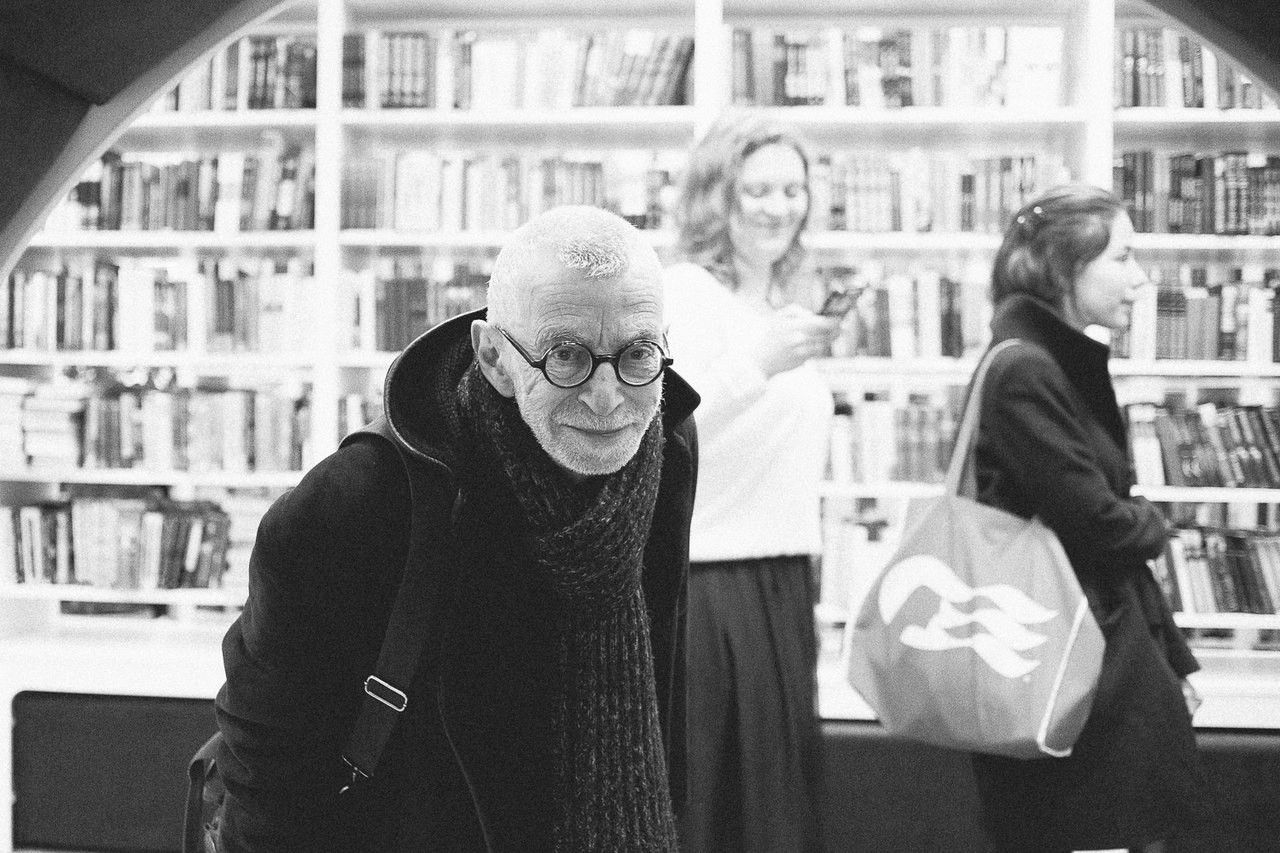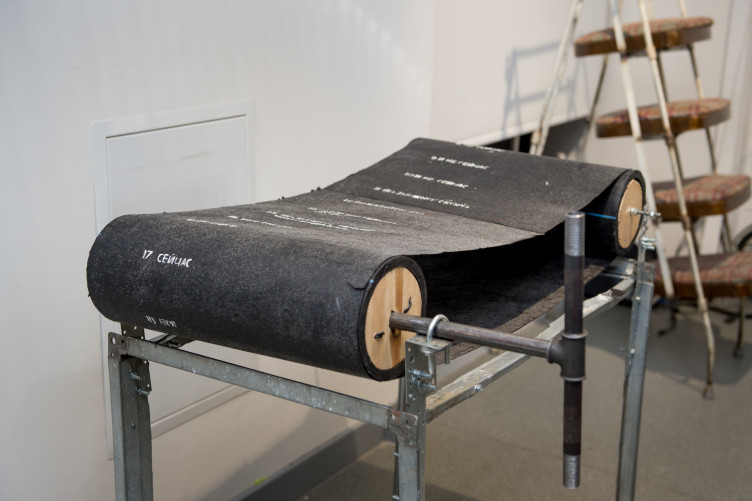Let's Go Farther*

The poet Lev Rubinstein died.
Five years ago, the first-year undergraduate students at the Moscow School of Architecture MARCH were given the exercise 'Object of Poetic Response' by the Volnaya Studio ('Free Workshop'). The exercise combined various creative methods and referred to several artistic traditions.
Guided by their tutors, students were challenged to create an object with zero budget, drawing inspiration from found art, Dadaism, and art brut.
The final object served as a dynamic prop in a poetry reading, set in a carefully chosen location that complemented site-specific and performance art practices. The object, functioning as both scenography and a theatrical machine with Constructivist influences, implicitly referenced Vsevolod Meyerhold’s 'Free Workshop' of the 1920s.
The ultimate goal of the exercise was to utilize the created object as a medium for reciting a poem by a contemporary Russian poet, notably those linked to the Moscow Conceptualism movement. The list featured Lev Rubinstein.
The students' performances were recorded on video. Projects featuring poems by Lev Rubinstein were created by: Nikita Fadin, Evgeny Kurenkov, Anna Nemtsova and Nikita Sinyavsky.
At its core, this exercise explores the interplay between fragments and the whole, reflecting a fundamental principle in both poetry and architecture. Lev Rubinstein, in his distinctive note card genre, also embraced this dialectic connection. Here is how the poet himself described the innovative literary form he pioneered:
'In the mid '7os, I created my own genre — a genre of note cards, corresponding to my aspiration, at the time, to overcome inertia and the gravitation of the flat page. To an even greater degree, I resorted to this unconventional genre because of my distinct desire to transfer the situation of 'samizdat' [Soviet self-publishing], by then solidified and seemingly eternal, from a socio-cultural dimension to a purely aesthetic one. I was utterly amazed by the vitality this genre has demonstrated over time. It has proved capable of self-development and self-modification.
Each of my works, which I define as 'texts, ' both explodes its generic tethers and creates new ones. Any fragment of the text, or the text as a whole, echoes traditional genres in accordance with the genre memory of the reader. Consequently, the text reads at times like a realistic novel, at times like a dramatic play, at times like a lyric poem, etc.; that is, it slides along the edges of genres and, like a small mirror, fleetingly reflects each of them, without identifying with any of them. This genre is, in essence, a hybrid genre, com-bining poetry, prose, drama, visual art, and performance.'
In 'The Origin of German Tragic Drama', Walter Benjamin comments on the unique nature of the fragment as an artistic form. Benjamin highlights how artistic expression in both the Baroque and Romantic periods employs the logic of the fragment in allegory. Benjamin cites the German poet Novalis:
'Poems, merely fine-sounding and full of beautiful words but without any meaning or coherence — no more than a few verses of which are comprehensible — like fragments of the most heterogeneous objects. True poetry can, at most, have an allegorical meaning as a whole, and its effect can, at most, be an indirect one, like that of music etc. Nature is therefore purely poetic, and so it is a magician’s den, a physicist’s laboratory, a children’s nursery, an attic and a lumber-room.'
It is no wonder that the last sentence of the passage introduces spatial metaphors. This dichotomy of fragments and wholes is not only a literary concept but also a prevalent theme in our experience of both natural and built environments. A building, by its very nature, cannot be fully seen all at once; each part suggests the whole coming as a blend of anticipation and memory.
The adage 'design the house down to the door handle' characterizes architects dedicated to meticulous detail and integrity of their style. However, achieving this level of unity can be challenging. Meanwhile, many architects and firms, with names like Alvar Aalto, Carlo Scarpa, FAT, and Caruso St. John readily coming to mind, have interpreted architecture as a composition of fragments, each in their unique way.
Diving deeper, certain postmodern architectural frameworks resonate profoundly with the structure and philosophy of Lev Rubinstein’s poetic approach. To understand this connection, one must look beyond the common perception of postmodernism as merely an obsession with quotation. The architectural practice of integrating fragments has historical roots dating back to late antiquity, exemplified by the concept of spolia. Postmodernism (notably a term with diverse interpretations, and this one here is neither exclusive nor definitive) strives to juxtapose distinct genres and linguistic codes within a single work, creating a complex interplay between each of the parts, and between all of them and the whole. Rubinstein depicted the protagonists in his note cards as entire systems composed of other texts, transcending mere individual words and sentences.
The approach at MARCH intertwines mosaic-like composition and deliberate intertextuality in architectural design, reflecting a conceptualist strategy that emphasizes form efficiency. In the practice of concept art, where communication itself becomes the subject, the task often involves unveiling the function of the sign. This process is typically achieved through the austerity of form: as simple as a note card with a single sentence, or even without any. Now, as in the Baroque and Romantic periods, the use of poetic fragments is strategically employed to stir the reader’s or viewer’s imagination. Engaging with this concentrated form demands of the viewer or reader an active invocation of memory, cultural experience, aesthetic intuition, and taste, bridging the gap between the fragments and the whole.

MARCH maintains a deep connection to the traditions of Moscow Conceptualism, evident both in many of its pedagogical practices and in the personal histories of its members: Lev Rubinstein and the school’s founder and dean, architect Eugene Asse were friends for many years. Traces of conceptualism are evident in the pedagogical strategies that explore the relationships between author and work, idea and form, as well as between work and its wider context, including architectural history, urban settings, and broader cultural dynamics. These conceptual connections manifest themselves in numerous individual exercises and are integral to the briefs set by MARCH studios.
Returning to the Volnaya experiment, we find that the propaedeutic exercise was designed with three distinct audiences in mind. The first audience is the students themselves. In this exercise, the students craft a 'fragment' of a cultural and spatial experience, which they subsequently expand upon and integrate into their architectural designs. Since the given fragment is a complex cultural event with multiple layers and dimensions, the architectural work can also reflect this complexity. The second audience is the school itself. Volnaya consistently addressed this audience, often employing critical irony to elevate established school practices to a mannerist level.
However, a third audience extends beyond the school’s boundaries; the exercise’s exposure reached a wider public. The video recordings of the exercise were shared with a wider audience, and during an offline event, students presented their interpretations to some of the poets themselves. This highlighted the importance of culture as a context in which the school and the students operated. The very first exercise of the course asked the students to relate themselves to the cultural landscape to which they belonged as participants in the educational project. This was a radical move.
It was both an invitation and a challenge, similar to the well-known encounter during the young Alexander Pushkin’s final exams, when the esteemed Gavrila Derzhavin was a member of the commission. Pushkin described some of the interesting details as follows:
'Delvig [Pushkin’s shool friend and also a poet] went to the stairs to wait for [Derzhavin] and kiss his hand, the hand that wrote 'Waterfall'. Derzhavin arrived. He entered the hall, and Delvig heard him ask the doorkeeper, "Where, brother, is the privy here?" This prosaic question disappointed Delvig, who canceled his intention and returned to the hall. Delvig told me this with surprising simplicity and cheerfulness. […] I don’t remember how I finished my reading, I don’t remember when I ran away. Derzhavin was delighted; he demanded me, wanted to embrace me… They looked for me, but did not find me…'
This diary entry is a subtle combination of the ironic and the sublime, of the openness and distance necessary to understand such an encounter with history, to realise one’s place in it, when it is still marked with a dotted line. One thing that sets this apart is that at MARCH, this encounter occurred not at the conclusion of the course, but at its inception. This enabled individuals to choose an alternative path or narrative, and many students took advantage of this opportunity, whether consciously or unconsciously.
Similar to Pushkin’s sense of a connection between his generation and that of Gavrila Derzhavin, the MARСH school, founded in 2012, shares a connection with Lev Rubinstein’s poetic practice of the 1970s and 1980s. At times, the events seemed to occur in the single landscape, albeit at a considerable distance and separated by several obstacles: hills, rivers, fences.
Lev Rubinstein participated in studio critiques on several occasions and, because of his close friendship with Eugene Asse, was considered a member of the school’s extended family. He had a captivating presence that anyone who was willing to embrace would find a true gift, radiating the essence of a living classic while maintaining a friendly and self-deprecating demeanour in conversation, regardless of the age or status of the interlocutor. This gift was the gift of being present in history.
The exercise described at the beginning of the text has lost much of its meaning in recent times as there is little left to refer to. The cultural landscape has undergone changes over the years, even prior to the passing of Lev Rubinstein. Although no new obstacles have arisen, the image appears faded and pale in places, like a watercolour painting touched by splashes of water. The departure of individuals, such as Lev Rubinstein, highlights that their presence has been largely symbolic for some time. The space they were associated with had already vanished earlier. 'But farther on, what’s meant to be will be.'*
*Rubinstein, Lev. 2014. Compleat Catalogue of Comedic Novelties. Translated by Philip Metres, Tatiana Tulchinsky. Brooklyn, NY: Ugly Duckling Presse.
